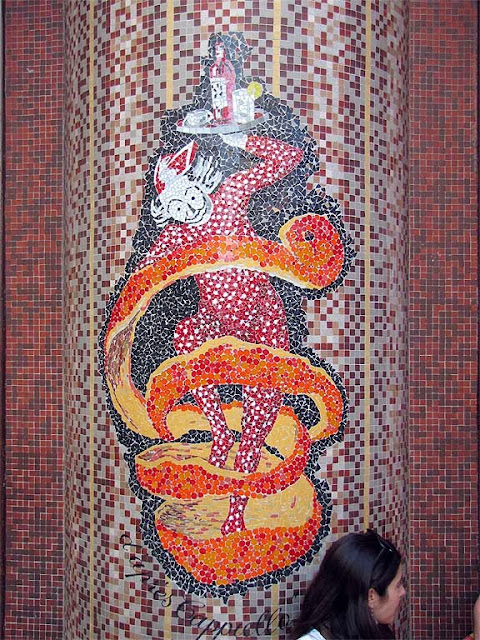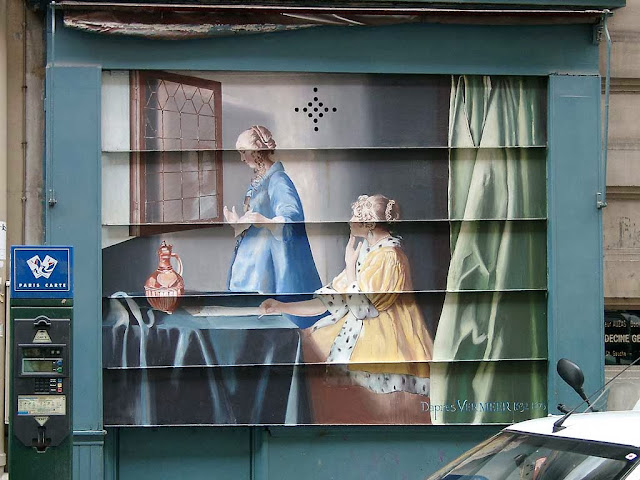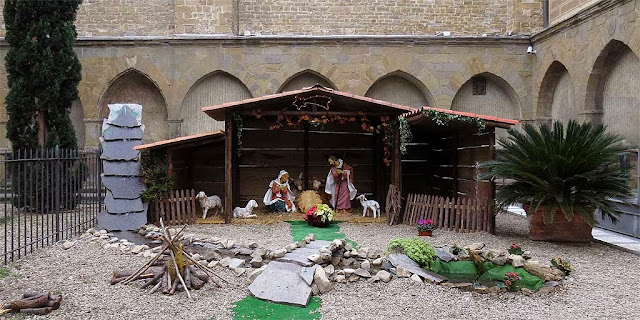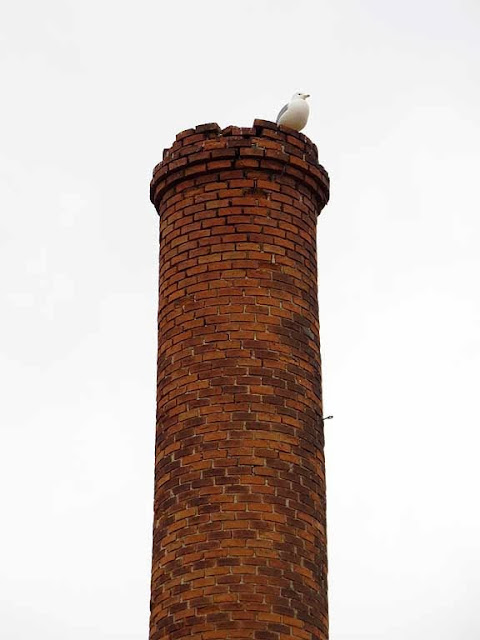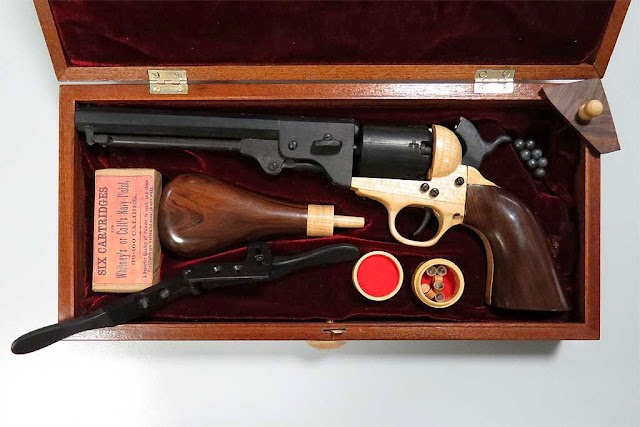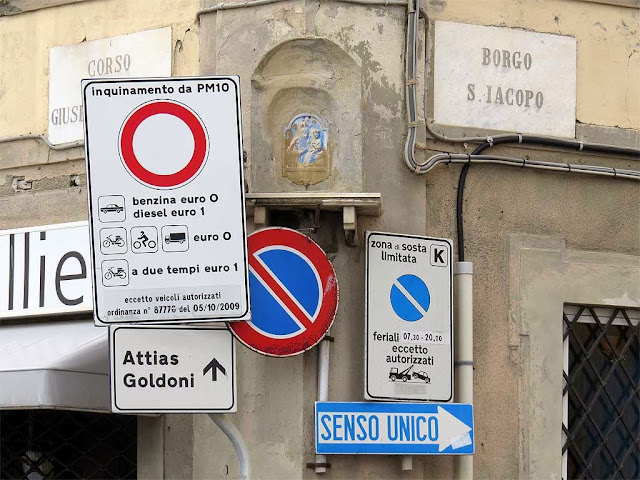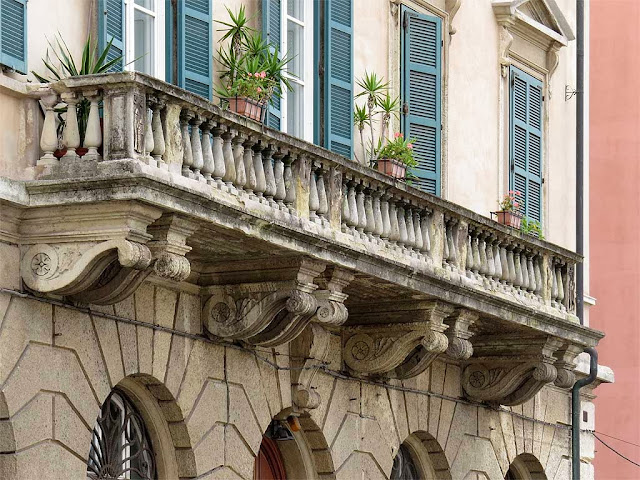The Cinema “Kino-Dessé” in Via dell’Angiolo was an avant-garde movie theater which has been open for the last ten years, with an affectionate but lately dwindling public. I said “was” because the theater closed for good last Sunday, not a very good news for the new year.
In the last months the owners asked for some solidarity, but they got thousands of “likes” on Facebook without selling one ticket more. The last show was sold out.
External links: Cinema Kino-Dessé (Website, in Italian) - Cinema Kino-Dessé (Facebook page, in Italian)
Tuesday, December 31, 2013
Monday, December 30, 2013
The Beggar of Livorno
Not much is left of what Amedeo Modigliani painted in Livorno, but “The Beggar of Livorno” is surely one of these works. In the summer of 1909 he was back in his hometown and it may be interesting to know how Jeanne Modigliani, in her biography of her father, tell us the story of this portrait à la Cézanne.
“The diary mentions that they had moved to Via Giuseppe Verdi and that, around 1909, they had received a legacy from someone called Castelnuovo. Moreover, in three letters that are undated but that refer to Castelnuovo's complicated will and speak of the baths at Pancaldi, Eugenia writes to Margherita: ‘Dedo is out of the house all day with a friend who has a studio.’ (This was Romiti.) ‘Caterina comes in by the day. Dedo and Laura are writing articles together, but they are too much up in the clouds for me.’ And at the end: ‘Dedo has seen the pictures, which he says are worthless, and also the famous statue.’ The statue was a late-Renaissance copy of a Greek Hermes, the pictures were a pastoral scene attributed to Salvator Rosa, a seascape by Tempesta, and a seventeenth-century Neapolitan picture of a beggar. In the famous Beggar of Leghorn, the watered-down Cézannesque structure reminds me of the Neapolitan composition; it seems to be a modern interpretation of an old picture and not an authentic portrait done from a model.”
External links: Amedeo Modigliani - Jeanne Modigliani (Wikipedia)
Search labels: Modigliani
“The Beggar of Livorno”, 1909
Oil on canvas, 66x52.7cm
Private collection
Oil on canvas, 66x52.7cm
Private collection
“The diary mentions that they had moved to Via Giuseppe Verdi and that, around 1909, they had received a legacy from someone called Castelnuovo. Moreover, in three letters that are undated but that refer to Castelnuovo's complicated will and speak of the baths at Pancaldi, Eugenia writes to Margherita: ‘Dedo is out of the house all day with a friend who has a studio.’ (This was Romiti.) ‘Caterina comes in by the day. Dedo and Laura are writing articles together, but they are too much up in the clouds for me.’ And at the end: ‘Dedo has seen the pictures, which he says are worthless, and also the famous statue.’ The statue was a late-Renaissance copy of a Greek Hermes, the pictures were a pastoral scene attributed to Salvator Rosa, a seascape by Tempesta, and a seventeenth-century Neapolitan picture of a beggar. In the famous Beggar of Leghorn, the watered-down Cézannesque structure reminds me of the Neapolitan composition; it seems to be a modern interpretation of an old picture and not an authentic portrait done from a model.”
(Jeanne Modigliani, Modigliani: Man and Myth)
External links: Amedeo Modigliani - Jeanne Modigliani (Wikipedia)
Search labels: Modigliani
Labels:
Livorno,
Modigliani,
painting
Sunday, December 29, 2013
Cemetery in Danger
“Besides the pillar to the memory of Smollett, and many others worthy of attention, I particularly paused on the tomb-stone of a mother, who died in bringing into the world two infants, who are buried with her in the same grave. The figure of the mother recumbent, and of the two babes, appeared to me beautiful and affecting, although somewhat impaired by time, and exposure to the open air.”
The grave is that of Mary Champion (1692-1721), of a well known Cornish merchant family. She married Thomas Mitchell (1687-1730), merchant in Livorno, secretary of the East India Company and nephew of Gilbert Heathcote (1651-1732), Fellow of the Royal Society, Lord Mayor of London, and Governor of the Bank of England. She was an aunt of the poet Anthony Champion (1725-1801) and niece of Francis Arundel (1659-1712), merchant in Livorno and Bath.
I am quoting this from the website of our friend Matteo Giunti, who is fighting another battle just now to protect this and other graves in the Old English Cemetery. In December 2011 the trunk of a tree fell on a tomb, smashing the gravestone to pieces. With the heavy winds of the last days the trunk of another tree has fallen, endangering more ancient graves, but nobody seems to care.
I wish to clarify that the cemetery has been perfectly kept for some years now, by Matteo and other volunteers: they routinely clean it up from weeds and make it available for the occasional visits. They only need some help in out-of-the-ordinary situations, like this one.
See also: Old English Cemetery
External links: Old English Cemetery, Livorno (Wikipedia)
The Old English Cemetery of Livorno in Quotes (Leghorn Merchant Networks)
Facebook Group: Salviamo l'Antico Cimitero degli Inglesi di Livorno (Save the Old English Cemetery of Livorno)
(Robert Semple, Observations on a Journey through Spain and Italy…, 1807, II, 16-18)
The grave is that of Mary Champion (1692-1721), of a well known Cornish merchant family. She married Thomas Mitchell (1687-1730), merchant in Livorno, secretary of the East India Company and nephew of Gilbert Heathcote (1651-1732), Fellow of the Royal Society, Lord Mayor of London, and Governor of the Bank of England. She was an aunt of the poet Anthony Champion (1725-1801) and niece of Francis Arundel (1659-1712), merchant in Livorno and Bath.
I am quoting this from the website of our friend Matteo Giunti, who is fighting another battle just now to protect this and other graves in the Old English Cemetery. In December 2011 the trunk of a tree fell on a tomb, smashing the gravestone to pieces. With the heavy winds of the last days the trunk of another tree has fallen, endangering more ancient graves, but nobody seems to care.
I wish to clarify that the cemetery has been perfectly kept for some years now, by Matteo and other volunteers: they routinely clean it up from weeds and make it available for the occasional visits. They only need some help in out-of-the-ordinary situations, like this one.
See also: Old English Cemetery
External links: Old English Cemetery, Livorno (Wikipedia)
The Old English Cemetery of Livorno in Quotes (Leghorn Merchant Networks)
Facebook Group: Salviamo l'Antico Cimitero degli Inglesi di Livorno (Save the Old English Cemetery of Livorno)
Saturday, December 28, 2013
Friday, December 27, 2013
Clet in Florence
Variations on a no-entry sign by Clet Abraham, this time on his home turf in Florence.
See also: Clet Abraham - On the Trail of Clet - Via dell'Olmo - Clet's Studio
Search labels: Clet Abraham
External links: Clet Abraham (Wikipedia, in French) - The language of the street signs by Clet Abraham (Abitare) - Interview with Clet (Daily Inspiration)
Piazza Santa Croce / Via Torta
Via delle Seggiole / Via dei Pandolfini
See also: Clet Abraham - On the Trail of Clet - Via dell'Olmo - Clet's Studio
Search labels: Clet Abraham
External links: Clet Abraham (Wikipedia, in French) - The language of the street signs by Clet Abraham (Abitare) - Interview with Clet (Daily Inspiration)
Labels:
Clet Abraham,
Florence,
sign
Thursday, December 26, 2013
D'après Cappiello
If you know the works of the Livornese poster artist Leonetto Cappiello, it would be easy to recognize the image of his famous 1921 Bitter Campari advertising. You will find this mosaic outside the Bar du Marché, on the corner of rue de Seine with rue de Buci, in Paris.
See also: Leonetto Cappiello
External links: Leonetto Cappiello (Wikipedia)
See also: Leonetto Cappiello
External links: Leonetto Cappiello (Wikipedia)
Wednesday, December 25, 2013
Tuesday, December 24, 2013
Piazza del Duomo
A Christmas tree decorated with Florentine lilies in Piazza del Duomo (Cathedral Square) in Florence.
External links: Piazza del Duomo - Florence Cathedral (Wikipedia)
External links: Piazza del Duomo - Florence Cathedral (Wikipedia)
Monday, December 23, 2013
Rue Cavallotti
One of the most interesting events of “Street Art Meets Modigliani” was the part where street artists were recreating some artworks of the Livornese painter. This reminded me of an interesting place in Paris: rue Cavallotti, a short street in the 18th arrondissement that strangely comes alive when the shops close their heavy shutters, decorated following the style of famous painters.
Sadly it didn't last: these photos were taken in July 2004 and a few years later the paintings had already been ferociously defaced by taggers. In summer 2011 the shutters were repainted with names and logos of famous venues of the Belle Époque.
External links: Que deviennent les rideaux peints de la rue Cavallotti? (Inside Paris, in French)
- Rue Cavallotti : The smallest open-air art museum in Paris! (Les Studios de Paris)
“Seated Woman with Child” (Motherhood), 1919
d'après Modigliani (1884-1920)
d'après Modigliani (1884-1920)
A mix of “Arearea” (Joyousness), 1892
and “Ia Orana Maria” (Hail Mary), 1891
d'après Gauguin (1848-1903)
and “Ia Orana Maria” (Hail Mary), 1891
d'après Gauguin (1848-1903)
A mix of “Woman in Blue Reading a Letter”, 1663
and “Mistress and Maid”, 1667
d'après Vermeer (1632-1675)
and “Mistress and Maid”, 1667
d'après Vermeer (1632-1675)
Sadly it didn't last: these photos were taken in July 2004 and a few years later the paintings had already been ferociously defaced by taggers. In summer 2011 the shutters were repainted with names and logos of famous venues of the Belle Époque.
External links: Que deviennent les rideaux peints de la rue Cavallotti? (Inside Paris, in French)
- Rue Cavallotti : The smallest open-air art museum in Paris! (Les Studios de Paris)
Sunday, December 22, 2013
Christmas in Florence
Our friend Karl of Bolzano Daily Photo asked me yesterday how I was going to celebrate the anniversary of this blog. My answer was: not posting about Livorno for a few days. Welcome to Christmas in Florence!
A simple nativity scene in in Piazza del Duomo (Cathedral Square), on the left of Santa Maria del Fiore.
Another nativity scene, with also a waterfall. It is set in what once was the Cemetery of Plaona, on the right side of the Basilica of Santa Maria Novella, and it is seen from the entrance of Via degli Avelli.
External links: Piazza del Duomo - Florence Cathedral - Basilica of Santa Maria Novella (Wikipedia)
A simple nativity scene in in Piazza del Duomo (Cathedral Square), on the left of Santa Maria del Fiore.
Another nativity scene, with also a waterfall. It is set in what once was the Cemetery of Plaona, on the right side of the Basilica of Santa Maria Novella, and it is seen from the entrance of Via degli Avelli.
External links: Piazza del Duomo - Florence Cathedral - Basilica of Santa Maria Novella (Wikipedia)
Labels:
Christmas,
Florence,
nativity scene
Saturday, December 21, 2013
Five Years
We are happy to celebrate Livorno Daily Photo's fifth anniversary: with 1829 posts and more than 4000 photos published, this is something we never imagined to achieve when we started the blog. Blogitalia says that we are the first non-commercial blog in the Province of Livorno: not bad for a photoblog in English.
A heartfelt hello to our friends, here in Livorno and in the rest of the world.
Anniversary posts: Anniversary Walk - Two Years - Three Years of PowerShots - Four Years
See also: Top Ranking Blog
External links: City Daily Photo (Portal) - Classifica blog provincia di Livorno (BlogItalia, in Italian)
A heartfelt hello to our friends, here in Livorno and in the rest of the world.
Anniversary posts: Anniversary Walk - Two Years - Three Years of PowerShots - Four Years
See also: Top Ranking Blog
External links: City Daily Photo (Portal) - Classifica blog provincia di Livorno (BlogItalia, in Italian)
Labels:
anniversary,
blog,
Livorno
Friday, December 20, 2013
Thursday, December 19, 2013
Piazza Amedeo Modigliani
During the events of last week, dedicated to Modigliani, some enthusiasts renamed Piazza Attias.
External links: Cronaca di “Street Art meets Modigliani”: Mostra e LivePainting (Occhio Livorno, in Italian)
Search labels: Modigliani
External links: Cronaca di “Street Art meets Modigliani”: Mostra e LivePainting (Occhio Livorno, in Italian)
Search labels: Modigliani
Labels:
Modigliani,
sign,
square
Wednesday, December 18, 2013
Checking Antennas
We have already seen these old silos, whose only useful purpose is that they host a lot of antennas.
After some strong wind in the past days, these technicians are probabling checking if the equipment is fine.
See also: Old Silos
After some strong wind in the past days, these technicians are probabling checking if the equipment is fine.
See also: Old Silos
Tuesday, December 17, 2013
Ouroboros
The Ouroboros is a symbol typical of ancient Egypt and Greece depicting a serpent eating its own tail, signifying the cyclicality of something constantly re-creating itself. As a Gnostic and alchemical symbol, it expresses the unity of all things, material and spiritual, which never disappear but perpetually change form in an eternal cycle of destruction and re-creation. You will find this door knob and knocker in Via Ricasoli.
On December 19th, two days after this post was published, the above piece showed up on page XII of the local daily “Il Tirreno”: the text is copied verbatim from the Italian version of this blog. I think any further comment is unnecessary.
See also: Snakes
On December 19th, two days after this post was published, the above piece showed up on page XII of the local daily “Il Tirreno”: the text is copied verbatim from the Italian version of this blog. I think any further comment is unnecessary.
(Updated on December 22nd)
External links: Ouroboros (Wikipedia)See also: Snakes
Monday, December 16, 2013
Portrait of Giovanni Fattori
At the turn of the century, the young Valmore Gemignani (Carrara 1878 - Florence 1958) was studying sculpture with Antonio Bortone at the Accademia di Belle Arti (Academy of Fine Arts) in Florence and was also taking drawing classes with Giovanni Fattori. Between 1902 and 1903, after a request by the painter himself, he modeled the small bronze “Ritratto di Giovanni Fattori” (Portrait of Giovanni Fattori), which shows the renowned master in a natural pose quite typical of him, without any magniloquence.
In 1925 the small bronze was used by the sculptor as a model for the Livornese statue, erected in a small square at the end of Via Vittorio Emanuele (now Via Grande). The monument barely escaped the ravages of the war and was placed for a long time in Villa Fabbricotti, where once was the Museo Fattori, now in Villa Mimbelli. The statue was replaced in its original location in 2008, for the hundredth anniversary of the death of the artist.
See also: Chili Pepper & Macchiaioli - Cisternino di città - Mazzini & Fattori - Villa Fabbricotti
External links: Antonio Bortone - Giovanni Fattori - Accademia di Belle Arti di Firenze - Amedeo Modigliani (Wikipedia)
In 1925 the small bronze was used by the sculptor as a model for the Livornese statue, erected in a small square at the end of Via Vittorio Emanuele (now Via Grande). The monument barely escaped the ravages of the war and was placed for a long time in Villa Fabbricotti, where once was the Museo Fattori, now in Villa Mimbelli. The statue was replaced in its original location in 2008, for the hundredth anniversary of the death of the artist.
See also: Chili Pepper & Macchiaioli - Cisternino di città - Mazzini & Fattori - Villa Fabbricotti
External links: Antonio Bortone - Giovanni Fattori - Accademia di Belle Arti di Firenze - Amedeo Modigliani (Wikipedia)
Labels:
Cisternino,
Livorno,
monument,
sculpture,
statue
Sunday, December 15, 2013
Sub-lieutenant
Two 1929 postcards with a funny depiction of the cadet's efforts to get at the end of their courses at the “Accademia Navale” (Naval Academy) of Livorno.
As you may notice, for the first time these postcards are superimposed with the address of the blog. This is because I am getting really tired of the usual serial leechers re-posting these images without any credits.
External links: Italian Naval Academy - Sub-lieutenant (Wikipedia)
See also: Mak Π 100
Search labels: cartolina
As you may notice, for the first time these postcards are superimposed with the address of the blog. This is because I am getting really tired of the usual serial leechers re-posting these images without any credits.
(Postcards digitized from the collection of Antonio Cantelli)
External links: Italian Naval Academy - Sub-lieutenant (Wikipedia)
See also: Mak Π 100
Search labels: cartolina
Saturday, December 14, 2013
A Like Attias
Piazza Attias, early afternoon on Sunday...
See also: Piazza Attias - The Big Red A - The New Attias
See also: Piazza Attias - The Big Red A - The New Attias
Friday, December 13, 2013
Chained
Via Marradi: the remains of a bike chained (in vain) to a convocation of the city council.
Search labels: bicycle art
External links: Bicycle Art
Search labels: bicycle art
External links: Bicycle Art
Labels:
bicycle art,
Livorno
Thursday, December 12, 2013
Passing Ferry
The stern of the “Moby Tommy” ferry, while leaving port, passes the green light.
Search labels: Moby - ferry
(Photo taken at full zoom last September)
See also: Moby Tommy - Traffic Jam - Green LightSearch labels: Moby - ferry
Wednesday, December 11, 2013
Busts on the Roof
In Livorno you can fish fake Modigliani's heads from the bottom of a canal, but you could also find some even more mysterious sculptures on the roof of a building in Piazza Mazzini. A local legend says that these busts are dedicated to the wives of an unlucky man who lost them in a short time, one after the other.
Anyway, the busts don't really look feminine: the right one has even some kind of winged cap like the one of the Roman god Mercury.
The second bust is too worn to make out any detail. If the legend is true, this tribute notwithstanding, I guess the poor guy had some troubles trying to marry again.
See also: Modì's Heads - Looking at the Sea
External links: Mercury (Wikipedia)
Anyway, the busts don't really look feminine: the right one has even some kind of winged cap like the one of the Roman god Mercury.
The second bust is too worn to make out any detail. If the legend is true, this tribute notwithstanding, I guess the poor guy had some troubles trying to marry again.
See also: Modì's Heads - Looking at the Sea
External links: Mercury (Wikipedia)
Tuesday, December 10, 2013
The Caged Lighthouse
When I last wrote about the lighthouse I told you that its look has recently changed: as you can see the 52-meter tower is now encased in an impressive scaffolding, probably for some kind of restoration.
See also: The Lighthouse
See also: The Lighthouse
Labels:
lighthouse,
Livorno,
port
Monday, December 9, 2013
Colt 1851 Navy Revolver
If you do not like guns do not worry, this Colt 1851 Navy Revolver is completely made of wood. Behind this masterpiece is the same craftsman who makes fine guitars and other string instruments: my friend Furio.
Everything is accurately made of wood: gun, balls, caps, powder flask, and even the bullet mold.
The revolver mechanism is obviously working: you can cock the hammer, which has a half-cock position, rotating the six round cylinder. You may and also use the loading lever or disassemble the gun completely.
See also: Lutherie Workshop - Cuatro, Clàrsach & Dulcimer - Guitars, at Last! - Ten-String Guitar
External links: Colt 1851 Navy Revolver (Wikipedia)
Everything is accurately made of wood: gun, balls, caps, powder flask, and even the bullet mold.
The revolver mechanism is obviously working: you can cock the hammer, which has a half-cock position, rotating the six round cylinder. You may and also use the loading lever or disassemble the gun completely.
See also: Lutherie Workshop - Cuatro, Clàrsach & Dulcimer - Guitars, at Last! - Ten-String Guitar
External links: Colt 1851 Navy Revolver (Wikipedia)
Labels:
Livorno
Sunday, December 8, 2013
Triumph TR3A
A Triumph TR3A in Piazza della Repubblica. (Picture taken last October)
External links: Triumph TR3 (Wikipedia)
See also: Tuscany and its People - Fiat 501 Torpedo - Moto Guzzi Normale - Sidecar - Bizzarrini 1900 GT Europa
External links: Triumph TR3 (Wikipedia)
See also: Tuscany and its People - Fiat 501 Torpedo - Moto Guzzi Normale - Sidecar - Bizzarrini 1900 GT Europa
Labels:
Livorno,
vintage car
Saturday, December 7, 2013
At Work inside the Fortress?
Our Fortezza Nuova (New Fortress) has been closed since early 2009, with rare openings of the hall at the entrance only for events or exhibitions. The last time I saw the park inside was in September 2009, but I can't really imagine how it is now after four years that it was practically abandoned and left by itself.
But someone was at work inside the fortress on Friday morning, pruning trees and tending the grass.
Maybe this is part of the frantic effort of sprucing up our town in view of next spring's local election.
See also: Fortezza Nuova - Inside the Fortress - From the Fortress - Fortress with a Secret - Fortress from the Sky
But someone was at work inside the fortress on Friday morning, pruning trees and tending the grass.
Maybe this is part of the frantic effort of sprucing up our town in view of next spring's local election.
See also: Fortezza Nuova - Inside the Fortress - From the Fortress - Fortress with a Secret - Fortress from the Sky
Labels:
Fortezza Nuova,
Livorno
Friday, December 6, 2013
Too Many Signs
At the corner of Corso Mazzini with Borgo San Jacopo: another clear case of too many road signs.
See also: Crazy Walk
See also: Crazy Walk
Thursday, December 5, 2013
Palazzo dell'Aquila Nera
This majestic facade on Scali D'Azeglio belongs to the Palazzo dell'Aquila Nera (Black Eagle Palace), one of the most remarkable buildings lining the Fosso Reale. The whole first floor of this palazzo, built in 1856, was occupied by the Grand Hotel Royal de l'Aigle Noir, a renowned luxury venue at the time. On the upper floors, divided into apartments, lived families of wealthy merchants.
See also: Black Eagle - Scali D'Azeglio - Reflected Eagle
See also: Black Eagle - Scali D'Azeglio - Reflected Eagle
Wednesday, December 4, 2013
Movie Projector
A vintage movie projector on display in the hall of the new La Gran Guardia cinema.
See also: La Gran Guardia - The New Gran Guardia - Old Counter, New Cinema
External links: Movie projector (Wikipedia)
See also: La Gran Guardia - The New Gran Guardia - Old Counter, New Cinema
External links: Movie projector (Wikipedia)
Tuesday, December 3, 2013
Monday, December 2, 2013
Bizzarrini 1900 GT Europa
The 1900 “Europa” was a small GT car produced by Bizzarrini between 1966 and 1969, powered by either an Opel or an Alfa Romeo engine. Only 17 cars of this type were ever made.
Giotto Bizzarrini is a Livornese engineer (actually he was born in Quercianella in 1926) who had worked for both Alfa Romeo and Ferrari before starting his own firm. In 1962 he designed a 3.5 liter V12 engine for Ferrucio Lamborghini which, in its basic layout, is still used today. He kept producing beautiful cars like this one, but never managed to get the recognition of most widely known brands of sport cars.
External links: Bizzarrini - Giotto Bizzarrini (Wikipedia)
- Giotto Bizzarrini: Engineering Excellence (Autoevolution)
See also: Tuscany and its People - Fiat 501 Torpedo - Moto Guzzi Normale - Sidecar
Giotto Bizzarrini is a Livornese engineer (actually he was born in Quercianella in 1926) who had worked for both Alfa Romeo and Ferrari before starting his own firm. In 1962 he designed a 3.5 liter V12 engine for Ferrucio Lamborghini which, in its basic layout, is still used today. He kept producing beautiful cars like this one, but never managed to get the recognition of most widely known brands of sport cars.
External links: Bizzarrini - Giotto Bizzarrini (Wikipedia)
- Giotto Bizzarrini: Engineering Excellence (Autoevolution)
See also: Tuscany and its People - Fiat 501 Torpedo - Moto Guzzi Normale - Sidecar
Labels:
Livorno,
vintage car
Sunday, December 1, 2013
Theme Day: Looking Out
Looking out from the bow of the “Corsica Victoria” ferry.
See also: Corsica Victoria
Search labels: ferry
See also: Corsica Victoria
Search labels: ferry
Subscribe to:
Comments (Atom)









